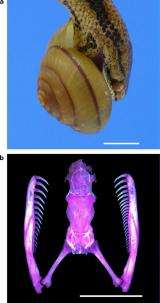December 10, 2010 report
Snails with shells coiling to the left survive snake attacks (w/ Video)

(PhysOrg.com) -- Snail shells can spiral to the left (sinistral) or to the right (dextral), as determined by a single gene, and a new study has found the advantage of being in the minority sinistral group: they survive predation by snakes much better than dextral snails. The effect of this advantage is so great they could separate into a distinct species.
Mating between sinistral and dextral snails is almost impossible because their genitals are on opposite sides of their bodies. In the large Satsuma snails, for example, mating takes place face-to-face. All snails have both male and female reproductive organs, and when both snails are dextral or both are sinistral, everything lines up nicely. When one is dextral and the other is sinistral the genitals line up male-male and female-female.
Dextral snails are far more common than sinistral snails, and therefore have far more mating opportunities. This and the difficulty in mating means sinistral snails should become extinct unless sinistrality has some unknown advantage. Now, scientists in Japan and Taiwan have discovered the advantage is a resistance to snake predation.
Southeast Asian snakes of the pareatidae family — the oriental slug-eating snakes — specialize in eating slugs and snails, and because the majority of snails are dextral with the shells on the right side, the snakes attack from the left, grabbing the shell with its upper jaw and sticking its lower jaw into the gap. The snakes have also evolved asymmetrical mouth parts with more fangs on one side than the other to help them eat the dextral snails. These changes, however, make it difficult for them to eat sinistral snails, especially as the snakes continue to attack from the left.
Researchers led by Dr. Masaki Hoso of Tohoku University looked at the distribution of Satsuma snails and the slug-eating snake species in Japan, and discovered that in areas where the snakes are found, sinistral Satsuma snails are more prevalent than elsewhere.
The team predicted that sinistral snails with larger shells such as Satsuma snails should also survive better than Bradybaena similaris snails, which have smaller shells, because they were more difficult for the snakes to handle.
To test their hypotheses the researchers kept sinistral and dextral snails of both species and exposed them to predation from slug-eating snakes. The results were that none of the dextral Satsuma snails escaped being eaten, but 87.5 percent of the sinistral snails survived. In the smaller snails the survival rate for sinistral snails was smaller but they still had a huge advantage over dextral snails.
The results led Dr. Hoso to predict that at some point the protection from predation would outweigh the mating difficulties and the chirality, or direction in which the shell coils, would become fixed in the opposite direction and the two groups become separate species and evolve their separate ways. To test this idea, the researchers sequenced the DNA of all Satsuma snail species found in Japan and built a family tree to show their relationships. The tree demonstrated clearly that sinistral species have evolved from dextral snails at least six times, and that in at least four of these occasions the reversal was due to a change in a single gene.
The reversal results in a massive advantage, because virtually overnight a group of snails is adapted to survive predation and is separated from other members of the species and can evolve separately. Hoso said these events represent the “hopeful monster,” an idea put forward by geneticist Richard Goldschmidt, who said small genetic changes could result in large evolutionary change.
The paper is published in the journal Nature Communications.
More information: A speciation gene for left–right reversal in snails results in anti-predator adaptation, Masaki Hoso et al, Nature Communications 1, Article number: 133. doi:10.1038/ncomms1133
© 2010 PhysOrg.com

















